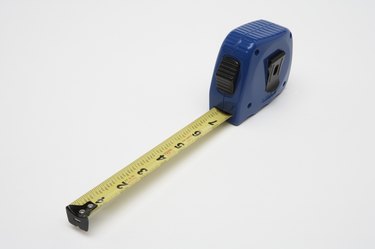Things You'll Need
Hammer
Tape measure
Hand square
Chalkline
Circular saw
Safety glasses
2 by 4 pressure-treated lumber
2 by 6 fir lumber
3-inch concrete nails
16d sinker or box nails

Building a framed wood floor over an existing concrete slab can provide the space needed for electric wiring, heat venting, plumbing drain lines and added insulation when remodeling a basement or garage space. The procedure for installing a floor structure over a slab with 2 by 6 joists can be adapted to larger joist sizes if more subfloor space is required.
Local and national codes contain specific requirements for framed floors and you should consult your local building department before beginning this project.
Video of the Day
Step 1
Define the area of the concrete slab to be covered with the floor assembly and the direction you plan to run the floor joists. Typically the joist direction is across the width or shorter dimension of the room or area.
Step 2
Measure the overall length of the new floor and cut a length of 2 by 4 pressure-treated lumber to this dimension for both sides of the room. Install it flat on the slab surface, with the outside edge aligned against the side wall or the edge of the floor line. Secure each length to the slab with concrete nails spaced approximately 32 inches apart and 8 to 12 inches from each end. These will be the end "sill plates" that support the ends of the floor joists.
Step 3
Divide the space between the two sill plates installed in Step 2 into equal spaces between 36 and 48 inches wide. Measuring from the same side, mark this dimension minus 1¾ inches on the slab at both sides of the floor area. Use a chalkline to snap lines on the slab at the offset marks, parallel to the support plates installed in Step 2.
Step 4
Begin at the chalkline marked in Step 3 and mark the slab at the equally divided dimension determined in Step 3 on both sides of the floor area. Snap a chalkline to connect each pair of these layout lines. These are the layout lines for the intermittent support plates.
Step 5
Cut lengths of 2 by 4 pressure-treated lumber for each layout line chalked in Steps 3 and 4. Secure each length of sill plate to the slab with concrete nails spaced approximately 32 inches apart and 8 to 12 inches from each end. These plates will provide the incremental joist support across the floor area.
Step 6
Begin at the same end of each of the support plates installed in Step 2 and use a tape measure to mark the first joist layout line on the plates at 15¼ inches. This offsets the layout so that all of the 16-inch center lines for the floor fall on the middle line of each joist. From this first line, make marks every 16 inches over the full length of the plates of both end plates.
Step 7
Pull a chalk line tight between the joist layout lines marked in Step 6 and snap a line to carry the joist layout onto the spaced joist support plates installed in Step 5.
Step 8
Measure the outside distance between the two end support plates installed in Step 2 as the joist length and cut a length of 2 by 6 lumber to this dimension. This is the first floor joist.
Step 9
Position the floor joist cut in Step 8 on edge at the end of the support plates the joist layout was started from in Step 6. Secure in place by nailing through the joist into the adjacent wall framing and/or diagonally through the side of the joist into the support plate at each location.
Step 10
Repeat Steps 8 and 9 for each joist at each layout line marked in Step 6.
Step 11
Cut 2 by 6 joist blocking by measuring the distance between the joists where they are secured to the support plates at both ends. This distance should be identical at each end. Cut all the blocks for each space to the same measurement to insure each joist is straight and all the joists in the floor structure maintain alignment. A row of solid cross-blocking or "bridging" perpendicular to the joists should be installed 6 to 8 feet apart over the length of the joists and at each end. With blocking complete, the joist structure is ready for subfloor utilities, insulation and plywood sub-flooring.
Tip
The pressure-treated sill plates can be secured to the slab with a powder-actuated nail gun, available for rental at most home improvement centers or construction rental yards.
Warning
If a powder-actuated nail gun is used for securing the pressure-treated sill plates to the slab, use safety glasses and follow all of the manufacturer’s safety instructions.
Video of the Day